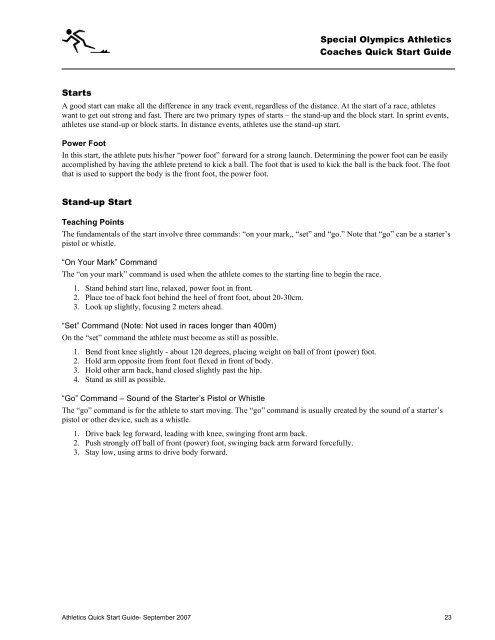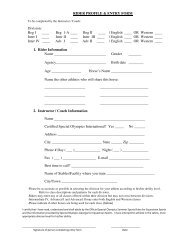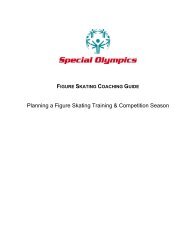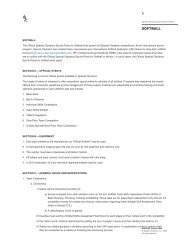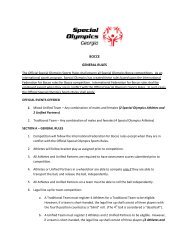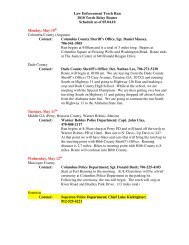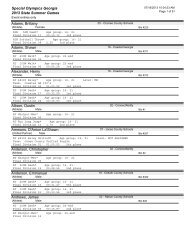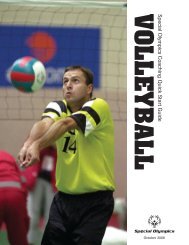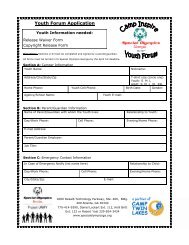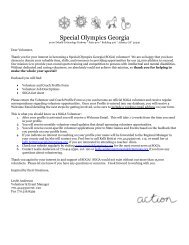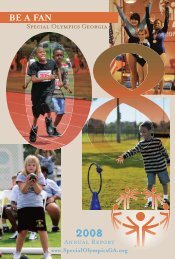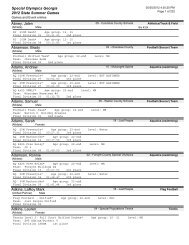Athletics Quick Start Guide - Special Olympics
Athletics Quick Start Guide - Special Olympics
Athletics Quick Start Guide - Special Olympics
You also want an ePaper? Increase the reach of your titles
YUMPU automatically turns print PDFs into web optimized ePapers that Google loves.
<strong>Special</strong> <strong>Olympics</strong> <strong>Athletics</strong><br />
Coaches <strong>Quick</strong> <strong>Start</strong> <strong>Guide</strong><br />
<strong>Start</strong>s<br />
A good start can make all the difference in any track event, regardless of the distance. At the start of a race, athletes<br />
want to get out strong and fast. There are two primary types of starts – the stand-up and the block start. In sprint events,<br />
athletes use stand-up or block starts. In distance events, athletes use the stand-up start.<br />
Power Foot<br />
In this start, the athlete puts his/her “power foot” forward for a strong launch. Determining the power foot can be easily<br />
accomplished by having the athlete pretend to kick a ball. The foot that is used to kick the ball is the back foot. The foot<br />
that is used to support the body is the front foot, the power foot.<br />
Stand-up <strong>Start</strong><br />
Teaching Points<br />
The fundamentals of the start involve three commands: “on your mark,, “set” and “go.” Note that “go” can be a starter’s<br />
pistol or whistle.<br />
“On Your Mark” Command<br />
The “on your mark” command is used when the athlete comes to the starting line to begin the race.<br />
1. Stand behind start line, relaxed, power foot in front.<br />
2. Place toe of back foot behind the heel of front foot, about 20-30cm.<br />
3. Look up slightly, focusing 2 meters ahead.<br />
“Set” Command (Note: Not used in races longer than 400m)<br />
On the “set” command the athlete must become as still as possible.<br />
1. Bend front knee slightly - about 120 degrees, placing weight on ball of front (power) foot.<br />
2. Hold arm opposite from front foot flexed in front of body.<br />
3. Hold other arm back, hand closed slightly past the hip.<br />
4. Stand as still as possible.<br />
“Go” Command – Sound of the <strong>Start</strong>er’s Pistol or Whistle<br />
The “go” command is for the athlete to start moving. The “go” command is usually created by the sound of a starter’s<br />
pistol or other device, such as a whistle.<br />
1. Drive back leg forward, leading with knee, swinging front arm back.<br />
2. Push strongly off ball of front (power) foot, swinging back arm forward forcefully.<br />
3. Stay low, using arms to drive body forward.<br />
<strong>Athletics</strong> <strong>Quick</strong> <strong>Start</strong> <strong>Guide</strong>- September 2007 23


